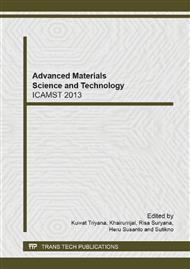p.267
p.272
p.276
p.280
p.284
p.288
p.292
p.296
p.300
Synthesis of Hydroxyapatite Nanoparticle from Tutut (Bellamya javanica) Shells by Using Precipitation Method for Artificial Bone Engineering
Abstract:
The synthesis and characterization of both structural and microstructure of hydroxyapatite (HAp) nanoparticles by using precipitation method have been performed. Orthophosphoric acid solution (H3PO4) 0.3 M was dropped into the suspension of Ca(OH)2 from tutut (Bellamya javanica) shells at pH 10 and added by NH4OH 1 M at the final deposition process. The precipitate was filtered and then heated in a furnace at temperature of 1000 °C for 3 hours. The result of elemental analysis showed that the Ca/P ratio of HAp sample was 1.71. X-ray diffraction patterns showed that the sample was a single phase of Ca10(PO4)6(OH)2 with hexagonal structure (P63/m) and lattice parameters of a = b = 9.418(3) Å, c = 6.885(2) Å, a = b = 90o, g = 120o, V = 528.9(4) Å3, and r = 3.084 g cm-3. The as-synthesized HAp has crystallite and particle sizes of 16.1055 and 89.15 nm, respectively. The TEM image revealed that the HAp particles have spherical-polygonal shape with an average diameter particles of around 10-20 nm. It was concluded that the synthesis of HAp nanoparticles from tutut (Bellamya javanica) shells by using a wet precipitation method has been successfully carried out and the as-synthesized HAp was potential to be applied as materials for artificial bone engineering.
Info:
Periodical:
Pages:
284-287
Citation:
Online since:
February 2014
Price:
Сopyright:
© 2014 Trans Tech Publications Ltd. All Rights Reserved
Share:
Citation:


